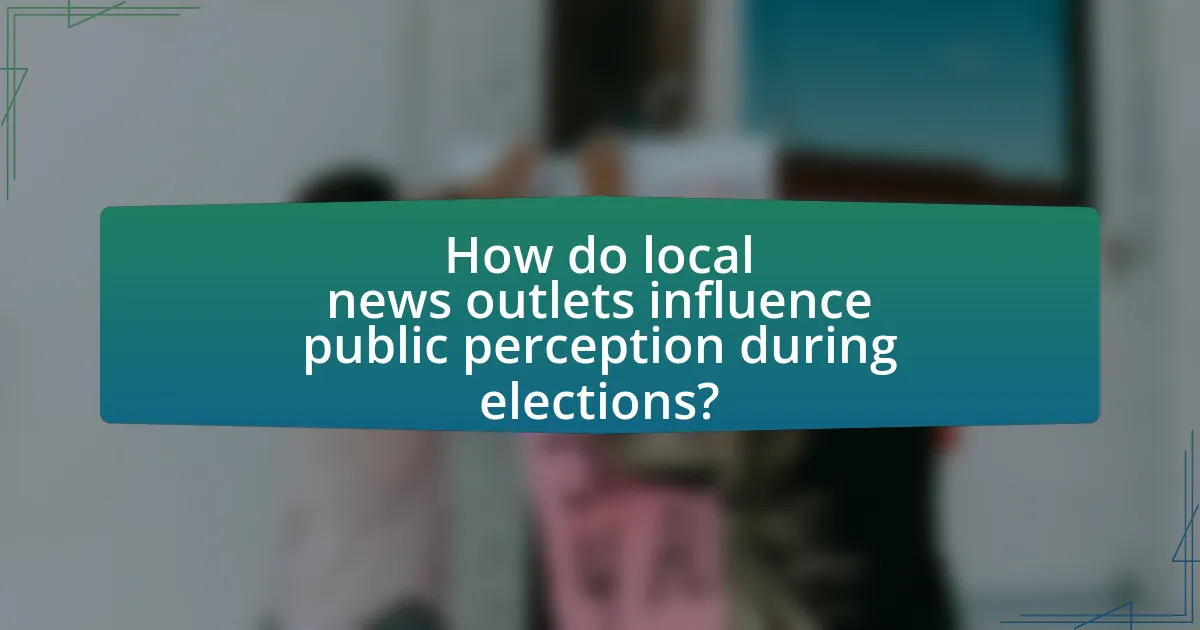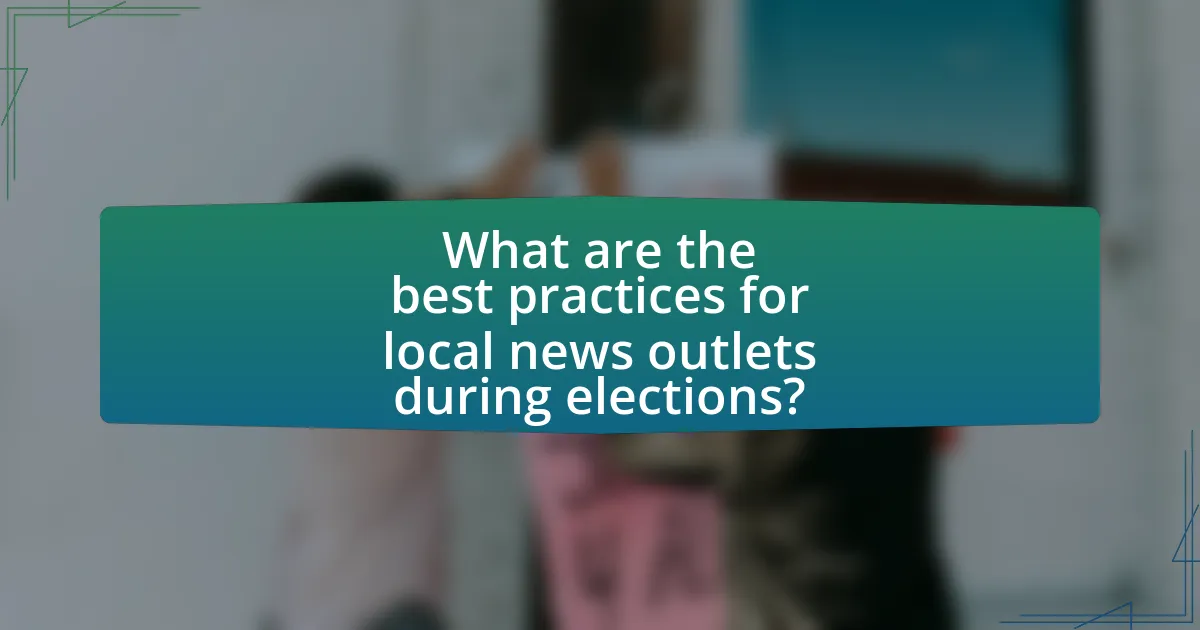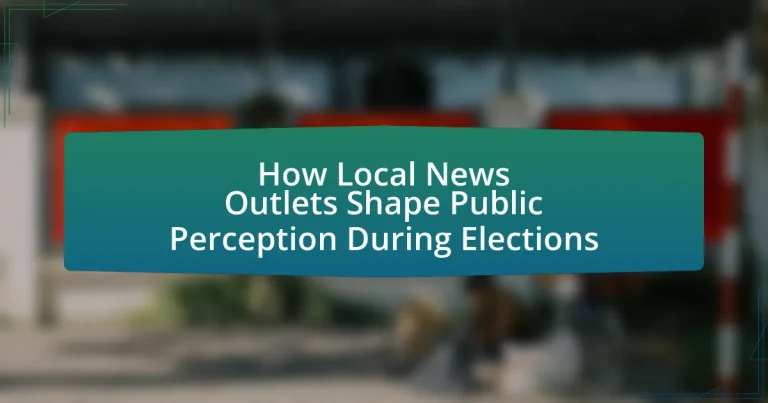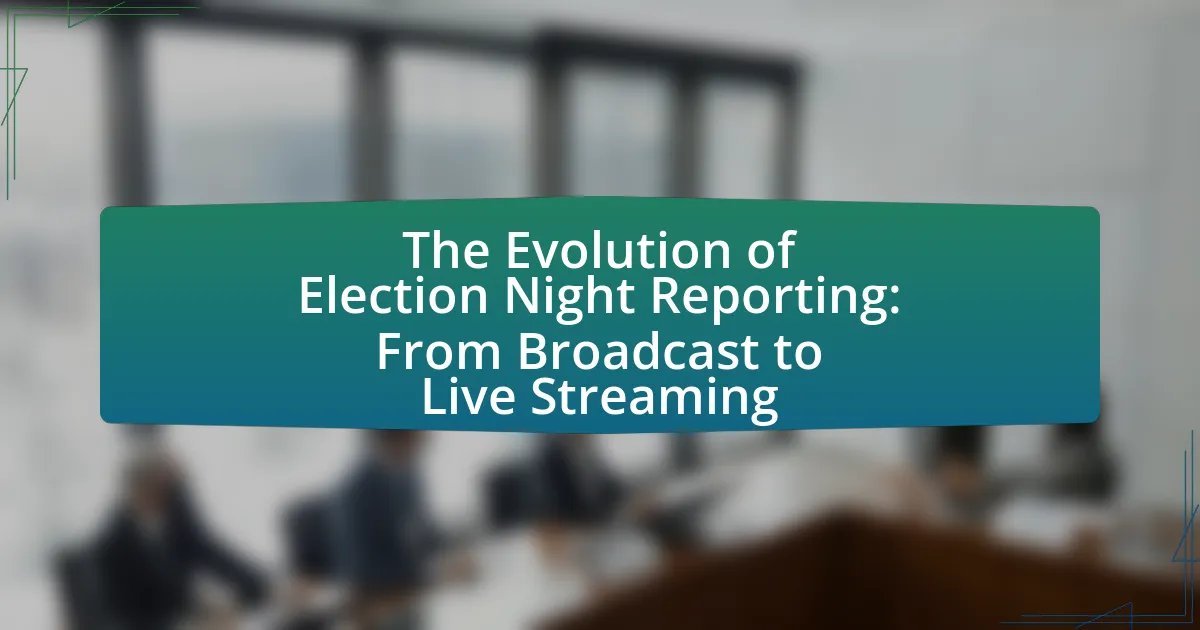Local news outlets play a pivotal role in shaping public perception during elections by providing localized coverage that influences voter opinions and behaviors. They highlight community-specific issues, which can significantly affect voter turnout and candidate favorability. The article examines how local news coverage impacts electoral narratives, the types of reporting that are most influential, and the challenges faced by these outlets, including financial constraints and audience fragmentation. It also discusses best practices for local news organizations to enhance their credibility and engagement with the community, ultimately emphasizing the importance of accurate and comprehensive reporting in fostering informed electoral participation.

How do local news outlets influence public perception during elections?
Local news outlets influence public perception during elections by shaping the narrative around candidates and issues through their coverage. They provide localized context that can highlight specific concerns relevant to the community, thereby affecting voter opinions and decisions. For instance, studies have shown that local news coverage can significantly impact voter turnout and candidate favorability; a 2018 study published in the Journal of Politics found that increased local news consumption correlated with higher voter engagement and informed decision-making. This demonstrates that local news outlets play a crucial role in framing electoral discourse and influencing public sentiment.
What role do local news outlets play in shaping electoral narratives?
Local news outlets play a crucial role in shaping electoral narratives by providing localized coverage that influences public perception and voter behavior. They focus on community-specific issues, candidates, and events, which helps to contextualize broader electoral themes within the local landscape. For instance, studies have shown that local news coverage can significantly affect voter turnout and candidate support by highlighting local concerns and framing issues in a way that resonates with the electorate. According to a 2020 report by the Pew Research Center, local news outlets are often the primary source of information for voters, making them instrumental in shaping the narratives that drive electoral decisions.
How do local news stories impact voter opinions and decisions?
Local news stories significantly influence voter opinions and decisions by shaping perceptions of candidates and issues. Research indicates that local news coverage often highlights community-specific concerns, which can sway voters’ priorities and preferences. For instance, a study by the Pew Research Center found that 62% of local news consumers believe local news helps them understand the issues facing their community, thereby directly affecting their voting behavior. Additionally, local news stories can create narratives around candidates, impacting their public image and voter trust. This localized focus ensures that voters are informed about relevant issues, ultimately guiding their electoral choices.
What types of coverage are most influential in shaping perceptions?
The types of coverage most influential in shaping perceptions during elections include investigative reporting, opinion pieces, and live event coverage. Investigative reporting uncovers critical information about candidates and issues, significantly impacting voter opinions; for instance, a study by the Pew Research Center found that 63% of voters reported changing their views based on investigative journalism. Opinion pieces provide editorial perspectives that can sway public sentiment, as evidenced by a 2018 analysis showing that 70% of readers felt more informed about candidates after reading opinion articles. Live event coverage, such as debates and rallies, offers real-time insights into candidates’ personalities and policies, influencing voter perceptions immediately; research indicates that 80% of viewers form opinions based on televised debates.
Why is local news coverage critical during election cycles?
Local news coverage is critical during election cycles because it provides voters with essential information about candidates, policies, and local issues that directly affect their communities. This localized reporting helps to inform public opinion and encourages civic engagement by highlighting the implications of electoral decisions on everyday life. Studies show that local news outlets significantly influence voter turnout; for instance, a 2018 study by the Pew Research Center found that communities with robust local news coverage saw higher voter participation rates compared to those with limited access to local journalism. This demonstrates that local news not only informs but also mobilizes citizens to participate in the democratic process.
How does local news coverage differ from national news coverage?
Local news coverage primarily focuses on community-specific issues, events, and concerns, while national news coverage addresses broader topics that affect the entire country. Local news outlets prioritize stories that resonate with their immediate audience, such as local elections, community events, and regional policies, which directly impact residents. In contrast, national news often covers significant political events, economic trends, and major social issues that may not have a direct local connection. For example, during elections, local news may provide in-depth analysis of local candidates and their platforms, while national news might focus on the overall election landscape and key battleground states. This distinction highlights how local news shapes public perception by emphasizing community relevance, thereby influencing voter engagement and awareness at the local level.
What are the implications of local news bias on public perception?
Local news bias significantly influences public perception by shaping the narratives and information that communities receive. Biased reporting can lead to skewed understandings of political candidates, issues, and events, ultimately affecting voter behavior and opinions. For instance, a study by the Pew Research Center found that local news outlets often prioritize sensational stories or those that align with their editorial slant, which can distort the public’s view of reality and create echo chambers. This selective coverage can reinforce existing beliefs and diminish exposure to diverse perspectives, thereby polarizing communities and impacting democratic engagement during elections.
How do local news outlets engage with their communities during elections?
Local news outlets engage with their communities during elections by providing comprehensive coverage of local candidates, issues, and voting procedures. They often host town hall meetings, debates, and forums to facilitate direct interaction between candidates and voters, fostering community dialogue. Additionally, local news organizations utilize social media platforms to disseminate information quickly and encourage public participation in discussions about the electoral process. According to a study by the Pew Research Center, 62% of local news consumers believe that their local news outlets play a crucial role in informing them about local elections, highlighting the importance of these outlets in shaping public perception and engagement during electoral periods.
What strategies do local news outlets use to connect with voters?
Local news outlets connect with voters through community engagement initiatives, targeted reporting, and interactive platforms. These strategies include hosting town hall meetings, conducting voter forums, and utilizing social media to facilitate direct communication with the audience. For instance, a study by the Pew Research Center found that local news organizations that actively engage with their communities through events and social media see higher audience trust and participation in local elections. This engagement fosters a sense of connection and relevance, encouraging voter turnout and informed decision-making.
How do community events and forums influence local news coverage?
Community events and forums significantly influence local news coverage by providing news outlets with relevant stories and firsthand accounts of public sentiment. These gatherings often serve as platforms for community members to express their opinions, concerns, and experiences, which local journalists can then report on to reflect the community’s voice. For instance, a study by the Pew Research Center found that local news organizations prioritize coverage of events that engage the public, as these stories resonate more with their audience and foster community connection. This dynamic ensures that local news remains relevant and responsive to the needs and interests of the community, particularly during election periods when public engagement is heightened.

What factors affect the effectiveness of local news outlets in elections?
The effectiveness of local news outlets in elections is primarily affected by their credibility, audience reach, and the quality of their reporting. Credibility influences public trust; for instance, a 2020 study by the Pew Research Center found that 71% of Americans believe local news is more trustworthy than national news. Audience reach determines how many voters are informed; local outlets with larger audiences can disseminate information more widely, impacting voter awareness and engagement. Additionally, the quality of reporting, including fact-checking and in-depth analysis, enhances the public’s understanding of candidates and issues, as evidenced by research from the Knight Foundation, which indicates that high-quality journalism correlates with increased civic participation.
How does the credibility of local news outlets impact public trust?
The credibility of local news outlets significantly impacts public trust by influencing how audiences perceive the reliability and accuracy of information. When local news outlets are viewed as credible, they foster a sense of trust among the community, leading to higher engagement with their content. Research indicates that 70% of people trust local news more than national news, highlighting the importance of local credibility in shaping public opinion. Furthermore, credible local news sources are more likely to provide accurate reporting on elections, which can enhance voter knowledge and participation. This relationship between credibility and trust is crucial, as it directly affects how effectively local news can inform and engage the public during critical events like elections.
What are the indicators of credibility in local news reporting?
Indicators of credibility in local news reporting include accuracy, transparency, and sourcing. Accurate reporting ensures that the information presented is factually correct, which is essential for building trust with the audience. Transparency involves disclosing the methods used to gather information and any potential conflicts of interest, allowing readers to assess the reliability of the news source. Sourcing refers to the use of credible and verifiable sources, such as expert opinions, official documents, and firsthand accounts, which enhances the legitimacy of the reported information. Studies have shown that audiences are more likely to trust news outlets that consistently demonstrate these indicators, thereby influencing public perception, especially during critical events like elections.
How can local news outlets improve their credibility during elections?
Local news outlets can improve their credibility during elections by ensuring accurate reporting and transparency in their sources. Accurate reporting involves fact-checking information before publication, which can be supported by using reputable sources and providing citations for claims made. Transparency can be enhanced by openly disclosing potential conflicts of interest and the methodologies used in gathering information. For instance, a study by the Pew Research Center found that 73% of Americans believe that transparency about sources increases trust in news organizations. By implementing these practices, local news outlets can foster greater trust among their audience during election periods.
What challenges do local news outlets face in election coverage?
Local news outlets face significant challenges in election coverage, primarily due to limited resources, competition from digital platforms, and political polarization. Limited resources often result in fewer reporters covering elections, which can lead to less comprehensive reporting. According to a 2020 Pew Research Center study, local newsrooms have seen a 25% decline in staff since 2008, impacting their ability to provide in-depth election analysis. Additionally, competition from digital platforms diverts audience attention and advertising revenue away from traditional outlets, making it harder for them to sustain election coverage. Political polarization further complicates their role, as audiences may distrust local news if they perceive it as biased, which can undermine the credibility essential for informing voters.
How do financial constraints affect local news reporting?
Financial constraints significantly limit local news reporting by reducing resources available for investigative journalism and comprehensive coverage. As local news outlets face declining advertising revenues and increased competition from digital platforms, they often cut staff and limit the scope of their reporting. For instance, a study by the Pew Research Center found that between 2004 and 2019, the number of local newspaper journalists in the U.S. decreased by nearly 50%, leading to less coverage of important local issues. This reduction in coverage can result in a less informed public, particularly during elections, as fewer resources are allocated to scrutinizing candidates and their policies.
What role does audience fragmentation play in local news effectiveness?
Audience fragmentation significantly diminishes local news effectiveness by dispersing viewership across various platforms and sources, leading to reduced engagement with community-focused reporting. This fragmentation results in a lack of a unified audience, which can weaken the impact of local news stories that are crucial for informing citizens about local elections and issues. Research indicates that as audiences increasingly turn to niche media outlets, the overall reach and influence of traditional local news diminish, making it harder for these outlets to foster informed public discourse. For instance, a study by the Pew Research Center found that 62% of Americans get news from social media, which often prioritizes sensationalism over local relevance, further complicating the role of local news in shaping public perception during elections.
How do technological advancements influence local news coverage?
Technological advancements significantly enhance local news coverage by enabling faster dissemination of information and broader audience reach. For instance, the rise of digital platforms allows local news outlets to publish stories in real-time, ensuring that communities receive timely updates on critical events, such as elections. According to a Pew Research Center study, 73% of Americans access news through digital devices, highlighting the shift from traditional print to online formats. This transition not only increases accessibility but also encourages local news organizations to engage with audiences through social media, fostering interactive discussions and immediate feedback. Furthermore, advancements in data analytics allow local news outlets to tailor content to specific demographics, improving relevance and engagement during election cycles.
What impact do social media platforms have on local news dissemination?
Social media platforms significantly enhance local news dissemination by providing immediate access to information and facilitating broader audience engagement. These platforms allow local news outlets to share updates rapidly, reaching audiences who may not consume traditional media. According to a Pew Research Center study, 53% of U.S. adults report getting news from social media, indicating its role as a primary news source. Additionally, social media enables local news organizations to interact with their communities, gather feedback, and tailor content to audience preferences, thereby increasing relevance and impact during critical events like elections.
How can local news outlets leverage technology to enhance engagement?
Local news outlets can leverage technology to enhance engagement by utilizing social media platforms, mobile applications, and data analytics. Social media allows these outlets to reach wider audiences and foster real-time interactions, as evidenced by a Pew Research Center study showing that 62% of adults get news from social media. Mobile applications can provide personalized content and notifications, increasing user retention and interaction. Additionally, data analytics can help local news outlets understand audience preferences and tailor content accordingly, leading to higher engagement rates. For instance, a report from the Knight Foundation highlights that news organizations using audience data saw a 30% increase in user engagement.

What are the best practices for local news outlets during elections?
Local news outlets should prioritize accuracy, impartiality, and community engagement during elections. Ensuring factual reporting helps maintain credibility and trust among the audience, which is crucial in a politically charged environment. For instance, the Pew Research Center found that 62% of Americans believe local news is essential for understanding local elections, highlighting the importance of reliable information.
Additionally, local news outlets should provide comprehensive coverage of all candidates and issues, facilitating informed decision-making among voters. This includes hosting debates, publishing candidate profiles, and fact-checking claims made during campaigns. According to a study by the Knight Foundation, voters who receive diverse and thorough information are more likely to participate in elections.
Engaging with the community through forums and social media can also enhance the outlet’s role as a trusted information source. By fostering dialogue and addressing local concerns, news outlets can better serve their audience and contribute to a more informed electorate.
How can local news outlets ensure balanced reporting during elections?
Local news outlets can ensure balanced reporting during elections by implementing strict editorial guidelines that promote impartiality and fairness. These guidelines should include diverse sourcing, where reporters seek input from multiple political perspectives, ensuring that all relevant voices are represented. For instance, a study by the Pew Research Center found that balanced coverage can enhance public trust in media, which is crucial during elections. Additionally, local news outlets should provide fact-checking resources to verify claims made by candidates, thereby reducing misinformation and bias. By adhering to these practices, local news outlets can contribute to a more informed electorate and foster a healthier democratic process.
What guidelines should local journalists follow to maintain objectivity?
Local journalists should adhere to guidelines that emphasize impartiality, fact-checking, and balanced reporting to maintain objectivity. These guidelines include verifying information from multiple credible sources before publication, avoiding conflicts of interest, and presenting diverse viewpoints on contentious issues. For instance, the Society of Professional Journalists’ Code of Ethics advocates for journalists to seek truth and report it, which reinforces the importance of accuracy and fairness in news coverage. Additionally, studies have shown that balanced reporting can enhance public trust in media, as evidenced by research from the Pew Research Center, which indicates that audiences are more likely to view news organizations as credible when they perceive them as unbiased.
How can local news outlets fact-check information effectively?
Local news outlets can fact-check information effectively by implementing a systematic approach that includes verifying sources, cross-referencing claims, and utilizing fact-checking tools. This process involves confirming the credibility of the information by consulting primary sources, such as official documents or expert opinions, and comparing it against established facts from reputable databases. For instance, organizations like PolitiFact and FactCheck.org provide resources that can assist in validating claims made during elections. By adhering to these methods, local news outlets can enhance their accuracy and reliability, thereby fostering informed public perception during electoral processes.
What strategies can local news outlets adopt to increase voter engagement?
Local news outlets can increase voter engagement by implementing community-focused reporting, hosting voter education events, and utilizing social media platforms effectively. Community-focused reporting allows local news to highlight issues that resonate with residents, fostering a sense of relevance and urgency around voting. Hosting voter education events, such as town halls or forums, provides direct interaction between voters and candidates, enhancing understanding of the electoral process and issues at stake. Additionally, leveraging social media platforms enables local news outlets to reach a broader audience, share timely information, and encourage discussions about voting, which can significantly boost voter turnout. Research indicates that local news coverage can increase civic participation by up to 20%, demonstrating the effectiveness of these strategies in mobilizing voters.
How can local news outlets utilize community feedback to improve coverage?
Local news outlets can utilize community feedback to improve coverage by actively soliciting input through surveys, social media engagement, and community forums. This approach allows news organizations to identify the topics that matter most to their audience, ensuring that coverage is relevant and reflective of community interests. For instance, a study by the Pew Research Center found that 73% of local news consumers prefer news that reflects their community’s concerns, indicating that feedback directly influences audience satisfaction and engagement. By integrating this feedback into their editorial processes, local news outlets can enhance their reporting quality and foster a stronger connection with their audience, ultimately shaping public perception more effectively during elections.
What role do partnerships with local organizations play in election coverage?
Partnerships with local organizations play a crucial role in election coverage by enhancing the reach and credibility of news outlets. These collaborations allow local news organizations to access community-specific insights, resources, and networks, which can lead to more comprehensive and relevant reporting. For instance, partnerships with civic groups can facilitate voter education initiatives, ensuring that information about candidates and issues is disseminated effectively. Research indicates that local news outlets that engage with community organizations are more likely to produce content that resonates with the electorate, thereby influencing public perception and voter turnout.
What are the key takeaways for local news outlets to enhance their impact during elections?
Local news outlets can enhance their impact during elections by prioritizing accurate reporting, engaging with the community, and providing comprehensive coverage of local candidates and issues. Accurate reporting builds trust and credibility, which is essential for informing voters; for instance, a study by the Pew Research Center found that 70% of Americans believe local news is essential for understanding local elections. Engaging with the community through forums and social media allows news outlets to gather diverse perspectives and foster dialogue, further enhancing their relevance. Additionally, comprehensive coverage that includes candidate interviews, debates, and issue analysis ensures that voters have the information needed to make informed decisions, as evidenced by research indicating that informed voters are more likely to participate in elections.




